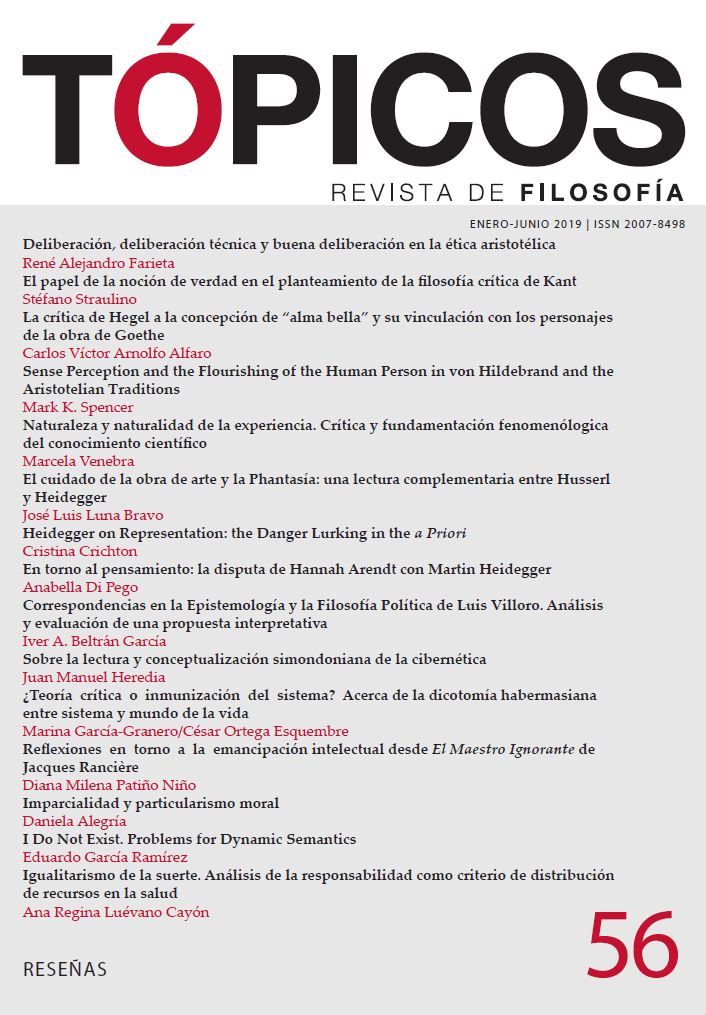Artículos
La crítica de Hegel a la concepción de “alma bella” y su vinculación con los personajes de las obras de Goethe
Publicado 2018-12-13
Palavras-chave
- determinación,
- universal,
- subjetividad,
- objetividad,
- deber
Como Citar
Alfaro, C. V. A. (2018). La crítica de Hegel a la concepción de “alma bella” y su vinculación con los personajes de las obras de Goethe. Tópicos, Revista De Filosofía, 56, 75-94. https://doi.org/10.21555/top.v0i56.958
Resumo
Hegel menciona al protagonista de Las Desventuras del joven Werther como un caso ejemplar de su particular concepción de “alma bella”. El filósofo alemán no incluye explícitamente a la protagonista de Confesiones de un alma bella. La omisión resulta curiosa porque la última obra mencionada también es una novela de Goethe. El objetivo del presente artículo es la dilucidación de la elección realizada por Hegel.
Referências
- Babbitt, I. (2010). Rousseau and Romanticism. Memphis: General Books.
- Blessin, S. (1979). Die Romane Goethes. Königstein: Athenäum Verlag.
- Fleischer, S. (1968). Bekenntnisse Einer Schönen Seele. Figural Representation in Wilhelm Meisters Lehrjahre. MLN. 83, 6. Comparative Literature, 807-820.
- Goethe, J. W. (1974). Las desventuras del joven Werther. J. L. Guarner (trad.) Barcelona: Editorial Bruguera S.A.
- ----(1841). Aus meinen Leben: Dichtung und Wahrheit. Leipzig: Philipp Reclam Verlag.
- ----(2001). Confesiones de un alma bella. S. Mas (int. y trad.) Madrid: A. Machado Libros S.A. (1870). Wilhelm Meisters Lehrjahre. Berlín: G. Grotesche Verlagsbuchhandlung.
- Harris, H. S. (1997). Hegel’s Ladder II: The Odyssey of Spirit. Indianápolis: Hackett Publishing Company, Inc.
- Hegel, G. W. F. (1966). Fenomenología del Espíritu. W. Roces (trad.) con la colaboración de R. Guerra. México D. F.: Fondo de Cultura Económica.
- ----(1989). Lecciones sobre la estética. A. Brotóns Muñoz (trad.) Madrid: Ediciones Akal, S.A.
- Heitner, R. R. (1980). Goethe’s Ailing Women. MLN, 95, 3, German Issue, 497-515.
- Milne, D. (2002). The Beautiful Soul: From Hegel to Beckett. Diacritics, 32, 1, Rethinking Beauty, 63+65-71+73-82.
- Norton, R. E. (1995). The Beautiful Soul: Aesthetic Morality in the Eighteenth Century. Itaca: Cornell University Press.
- Sax, B. C., (1983). Active Individuality and the Language of Confession: The Figure of the Beautiful Soul in the Lehrjahre and the Phänomenologie. Journal of the History of Philosophy, 21, 4, 437-466.
- ----(1987). Images of Identity: Goethe and the Problem of Self-Conception in the Nineteenth Century. New York: Peter Lang Publishing, Inc.
- Sharpe, L. (1991). Friedrich Schiller: Drama, Thought and Politics. Cambridge: Cambridge University Press.
- Speight, A. (2004). Hegel, Literature and the Problem of Agency. Cambridge: Cambridge University Press.
- von Mücke, D. (2000). Experience, Impartiality, and Authenticity in Confessional Discourse. New German Critique, 79, Special Issue on Eighteenth-Century Literature and Thought, 5-35.






